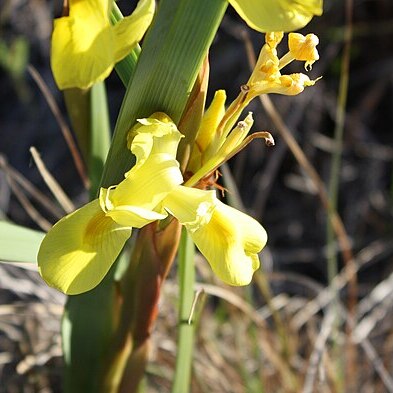Perennial herb, geophyte, 0.35-1.50 m high, solitary or in clumps; corm tunics of brown, coarse fibres; stem simple, sheathed with large overlapping bracts. Leaf 1, linear, flat or canaliculate, trailing above. Spathes herbaceous, apex dry, attenuate. Inflorescence with yellow flowers; nectar guides dark yellow; tepals unequal, outer 35-50 mm long, reflexed, inner 30-40 mm long, entire, with expanded limb, erect. Stamens: filaments 8-12 mm long, united in lower half; anthers 8-12 mm long. Ovary 20-30 mm long; style branches 12-18 mm long; crests up to 10 mm long. Flowering time Apr.-Dec. Capsule cylindric.
Cormous geophyte, up to 0.9 m high; cataphylls usually dark brown and often unbroken. Leaf solitary, flat above, 15 mm wide, twisted. Flowers: perianth with outer segments 35-50 mm long, yellow with deep yellow nectar guides on outer segments; Nov.-Feb.
Foliage leaf solitary, much exceeding the stem in length and usually arching towards the ground, 12–16 mm wide, linear, flat or channelled; sheathing leaves 2–3, green or becoming dry and brown, 10–15 cm long, rarely imbricate.
Cormous herb, up to 0.9 m high. Plants usually in clumps. Leaf flat above, 15 mm wide. Cataphylls usually dark brown and often unbroken. Flowers yellow with deep yellow nectar guides.
Flowers yellow with deep-yellow nectar guides on the outer tepals; outer tepals 35–50(60) mm long, the limb 20–35 mm long, spreading to reflexed; inner tepals 30–40 mm long, erect.
Rhipidium solitary; spathes green or becoming dry and brown from the apex, attenuate, the inner 10–14 cm long, the outer about three-quarters as long as the inner.
Cormous geophyte to 1 m, unbranched. Leaf solitary, linear, flat or channelled, often fairly broad. Flowers large, yellow, inner tepals erect.
Cataphylls prominent, brown to pale, firm in texture, brittle, dry, entire or irregularly broken, or frayed at the apex.
Ovary 2–3 cm long, exserted from the spathes; style branches 12–18 mm long, the crests c. 10 mm long.
Filaments 8–12 mm long, free in the upper half to one-third, anthers 8–12 mm long.
Plants large, 80–120 cm high, usually in small clumps or occasionally solitary.
Corms 15–20 mm in diameter; tunics of brown, fine to coarse fibres.
Capsules 3.5–5.5 cm long, oblong-cylindric.
Stem simple (rarely 1-branched).
Pending. See Messina (2014).
A corm or bulb plant.

